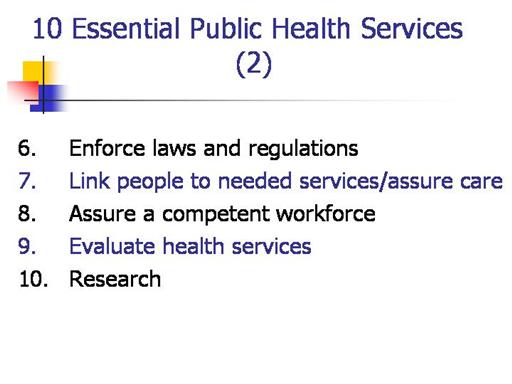| front |1 |2 |3 |4 |5 |6 |7 |8 |9 |10 |11 |12 |13 |14 |15 |16 |17 |18 |19 |20 |review |
 |
6.
Enforce Laws and Regulations that Protect Health and Ensure Safety
•- The review, evaluation, and revision of laws and regulations designed
•-- Protect health and safety;
•--
Reflect current scientific
knowledge; and
•--
Utilize best practice for achieving compliance.
•- Education of persons and entities obligated to obey or to enforce laws and
regulations designed to protect health and safety in order to
encourage compliance.
7.
Link People to Needed Personal Health Services and Assure the Provision
of Health Care when Otherwise Unavailable
•- Assessment of access to and availability of quality personal health care
services for the state's population.
•- Assurances that access is available to a coordinated system of quality care
which includes outreach services to link population to preventive
and curative care, medical
services, case management, enabling social and mental health services,
culturally and linguistically appropriate services, and health care
quality review programs.
8.
Assure a Competent Public and Personal Health Care Workforce
•- Assessment of workforce to meet community needs for public and personal
health services.
•- Maintaining public health workforce standards, including efficient
processes for licensure/credentialing of professional and incorporation
of core public health
competencies needed to provide the Essential Public Health Services into
personnel systems.
•- Adoption of continuous quality improvement and life-long learning programs
for all members of the public health workforce, including
opportunities for formal and
informal public health leadership development.
9.
Evaluate Effectiveness, Accessibility, and Quality of Personal and
Population-Based Health Services
•- Assessing the accessibility and quality of services delivered and the
effectiveness of personal and population-based programs provided.
•- Providing information necessary for allocating resources and reshaping
programs.
•- Utilization of technology and other methods to interpret and communicate
health information to diverse audiences in different sectors.
•- Collaboration in integrating and managing public health related information
systems.
10.
Research for New Insights and Innovative Solutions to Health Problems
A full continuum of research
ranging from field-based efforts to foster improvements in public health
practice to formal scientific research.
Linkage with research
institutions and other institutions of higher learning.
Internal capacity to mount
timely epidemiologic and economic analyses and conduct needed health
services research.
|